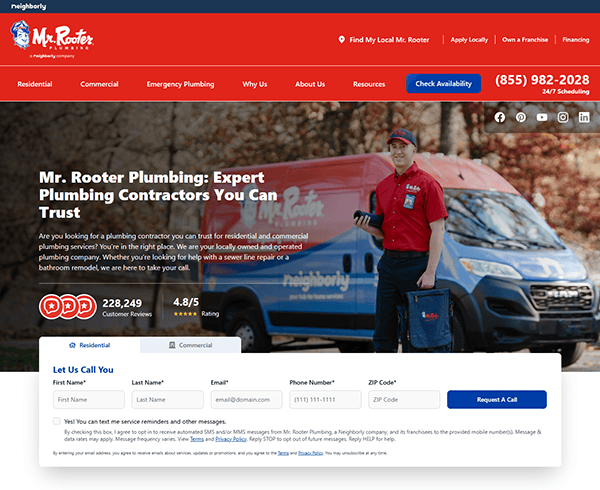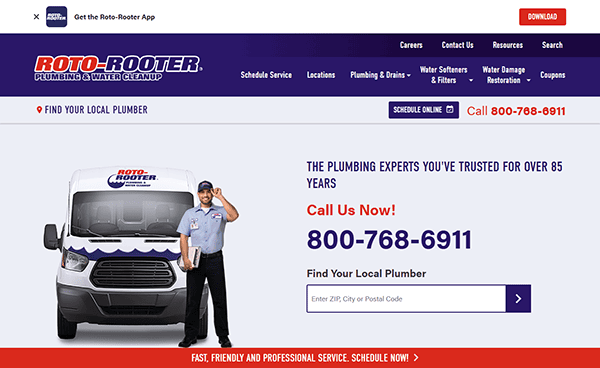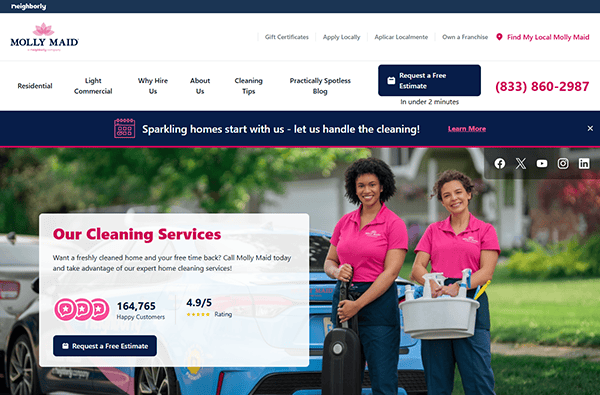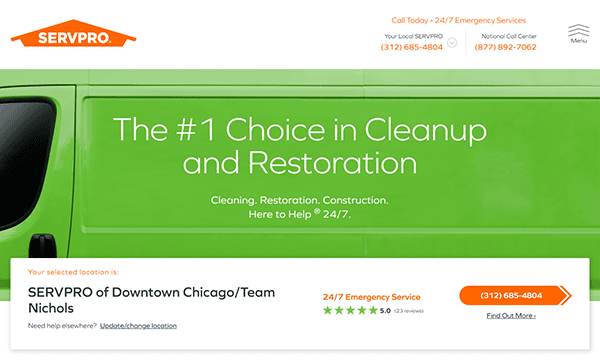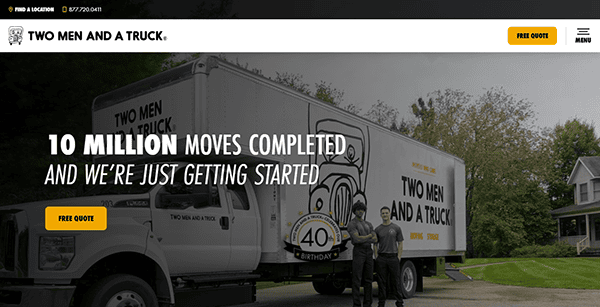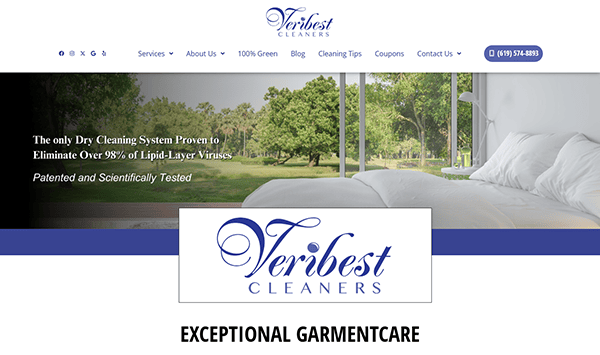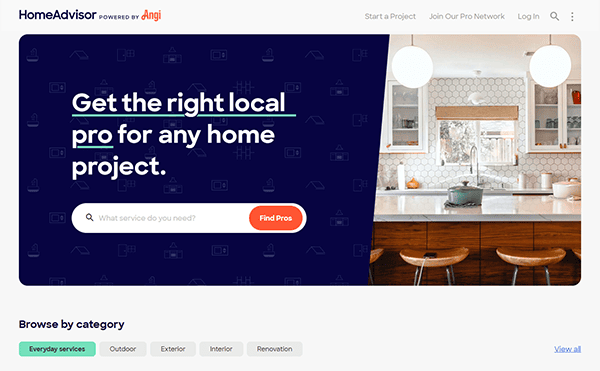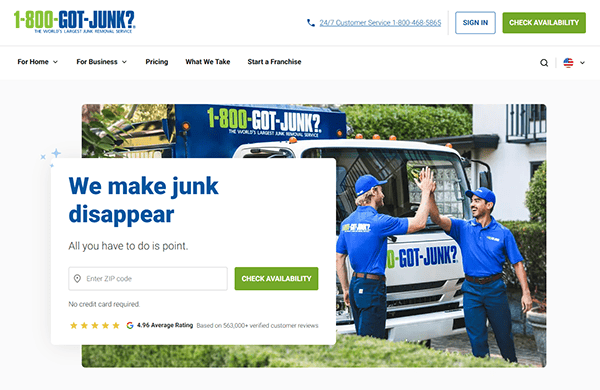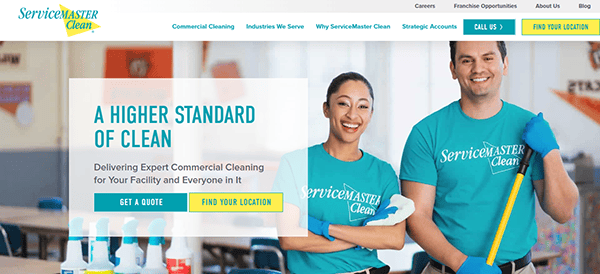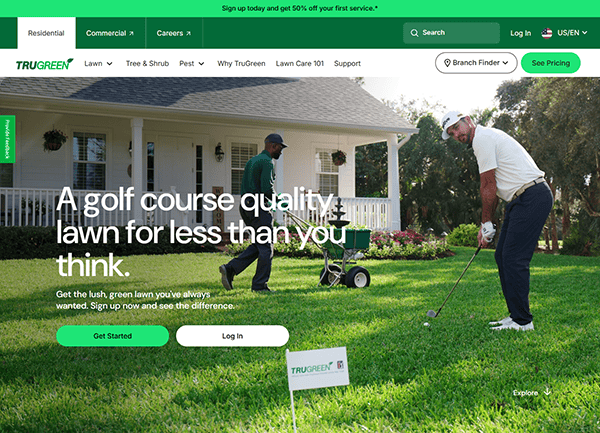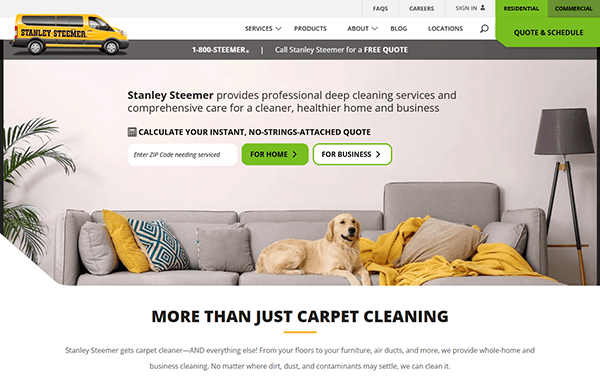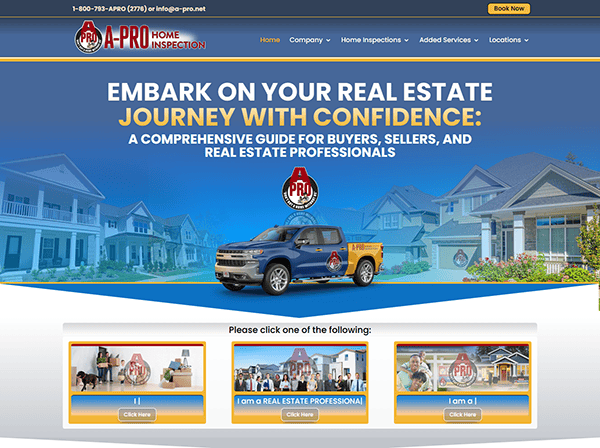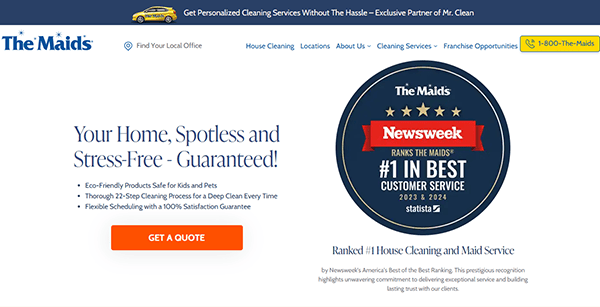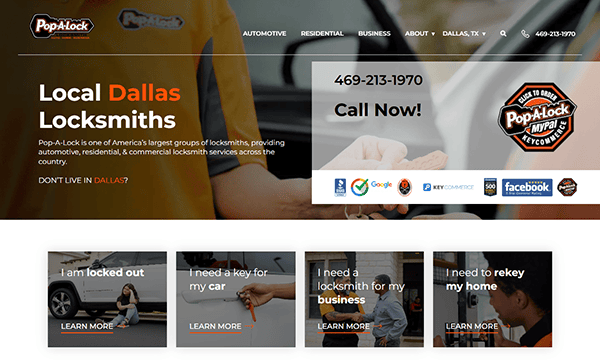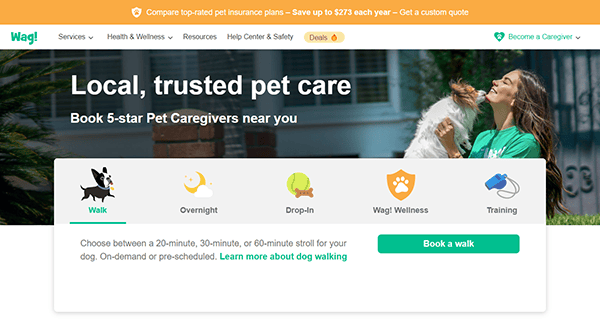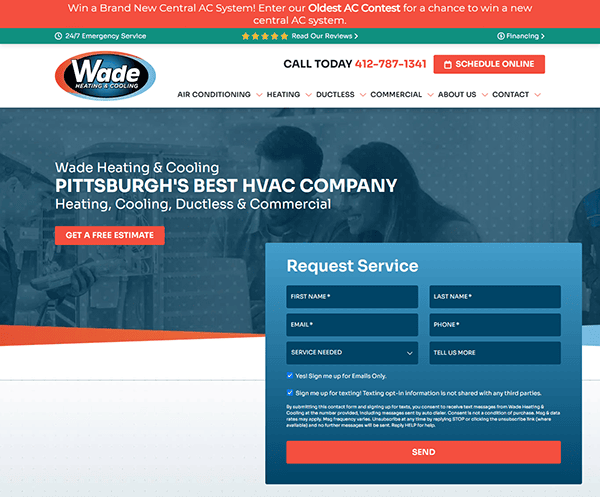Local service companies come in all shapes and sizes, from plumbers and electricians to pet groomers and home cleaning professionals. Regardless of your specific niche, every service-based business needs a strong digital presence to connect with customers. A well-structured website can provide a hub for essential information, streamline lead generation, and help highlight unique offerings in your market.
If you’re searching for inspiration for a new website for local services or are just curious about what works best in this industry, this post will guide you. We’ll walk through some standout designs, functionalities, and user experiences from local service businesses spanning a range of specialties. These local service website examples feature strategies you can apply to your own online presence—ensuring your site is easy to navigate, optimized for search engines, and capable of capturing potential clients.
Below, we’ll highlight 20 of the best local service websites that shine in terms of aesthetics and user experience. Each example offers valuable insights into what works for local service companies looking to gain a competitive edge online.
Examples of the Best Local Service Company Website Designs
- Mr. Rooter Plumbing: Its website presents a clean, professional design that immediately conveys trust and authority in the plumbing industry. Their service offerings are neatly organized, making it easy for visitors to find what they need quickly. The homepage features prominent calls to action and clear contact information so potential customers can reach out without any hassle. User testimonials and guarantees are placed strategically, adding layers of credibility. The color scheme is welcoming yet bold, ensuring critical information stands out. By incorporating a user-friendly interface and engaging content, Mr. Rooter sets a high bar for local service provider websites.

- Roto-Rooter: Roto-Rooter’s site captures your attention immediately with strong branding and clear service categories. The homepage’s prominent search bar allows visitors to find local branches quickly, reinforcing that they are a nationwide brand with regional reach. The design is crisp and easy to navigate, pairing bold colors with plenty of white space to reduce clutter. Their scheduling system is simple, allowing customers to book appointments in a few clicks. With a strong emphasis on professionalism and a visually consistent layout across pages, Roto-Rooter’s web presence demonstrates an effective model for local service companies.

- Molly Maid: Molly Maid offers an exceptional layout that balances bright imagery with precise service details, highlighting the reliability and warmth of their cleaning services. The site’s user-friendly interface encourages visitors to explore cleaning packages, learn about the brand’s history, and quickly schedule services. Trust factors such as customer reviews, satisfaction guarantees, and special offers are displayed prominently, reinforcing the brand’s credibility. Their blog provides household tips, giving visitors added value beyond just booking a cleaning. The cohesive color palette and well-organized navigation further elevate the user experience, making the website informative and inviting.

- SERVPRO: Its website tackles the complexities of disaster restoration with clarity and confidence. The homepage highlights various emergencies—fire, water, and mold damage—and directs customers to the needed help. Engaging visuals demonstrate before-and-after scenarios, reinforcing the brand’s capabilities. The contact tools are front and center, with a strong emphasis on their 24/7 availability. A clean design and straightforward content structure allow visitors to quickly navigate service pages, read testimonials, and request assistance. By prioritizing easy access to crucial information, SERVPRO’s site effectively addresses the concerns of clients who need urgent support.

- Handy: Handy’s site caters to a broad range of local services—from cleaning to handyman tasks—and effectively organizes these offerings. The main landing page conveys an instant sense of convenience and fast booking, enticing users to explore further. Strong visuals and concise copy highlight their commitment to professionalism and customer satisfaction. A modern, mobile-friendly design ensures that busy individuals can book on the go. Trust seals, real-time pricing, and rating systems provide transparency, increasing consumer confidence. Overall, Handy demonstrates how a simplified, intuitive website can streamline the path to conversion for multiple service categories.

- TaskRabbit: The modern design appeals to anyone looking for quick help with everyday tasks. Visitors can easily connect with skilled local “Taskers” who offer moving, furniture assembly, and yard work services. Their search and filter options provide a personalized experience, allowing users to find exactly what they need. Client testimonials and star ratings give TaskRabbit credibility, while its blog and FAQs offer insightful guidance. The site’s consistent branding, friendly visuals, and focus on convenience make it a strong example of how local service companies can leverage a marketplace-style model with an appealing user experience.

- Two Men and a Truck: This company emphasizes personal touch and reliability in their moving services. Their homepage has immediate calls to action for a free moving quote, making it easy for prospective clients to understand costs upfront. Information about local franchises is also highlighted, ensuring customers know the moving professionals in their area. Images of friendly staff and moving trucks create a sense of familiarity. With a straightforward layout, helpful tips for packing and moving, and flexible scheduling options, this website shines as a resourceful platform built around customer needs.

- VeriBest Cleaner: VeriBest Cleaners’ website presents a clean and professional design that reflects the company’s commitment to quality service. The homepage is well-organized, with straightforward navigation that makes it easy for users to find services, locations, and contact information. The soft blue and white color scheme feels fresh and welcoming, enhancing user experience. Prominent call-to-action buttons and concise text help guide visitors efficiently through the site. The inclusion of customer testimonials adds trust and credibility to the brand. Overall, the site’s responsive design and user-friendly layout make it easy to access on both desktop and mobile devices.

- HomeAdvisor: HomeAdvisor’s site focuses on helping homeowners find trusted local service providers. The homepage features a simple, bold interface with direct input boxes where users can identify what they need and their zip code. The site then generates a curated list of verified professionals. Rich content, including cost guides and project inspiration, further educates users before they hire. Testimonials and star ratings are presented, allowing potential clients to compare options easily. With a mobile-friendly design and a transparent approach to matching homeowners with reliable contractors, HomeAdvisor exemplifies how to build trust through an easy-to-use digital platform.

- 1-800-GOT-JUNK?: This junk removal service uses its homepage to present quick, clear calls to action, like “Schedule Now,” to capture leads. They explain the junk removal process with simple visuals and brief text, showcasing transparency. The bright color palette reinforces the brand’s approachable nature, and the layout helps visitors understand the different categories of items they can remove. Prominently displayed customer testimonials and a visible contact number offer easy ways to convert interest into bookings. Emphasizing convenience and clear communication demonstrates the impact of a streamlined design aimed at immediate user engagement.

- ServiceMaster Clean: ServiceMaster Clean offers an expansive suite of cleaning and restoration services, and their website neatly outlines each category for both residential and commercial clients. The use of comprehensive service descriptions, along with industry-specific certifications, reinforces trust. Visitors can quickly identify and navigate to the exact service they need through intuitive menus and clear calls to action. The color palette is professional and calm, aligning well with the brand image of reliability and thoroughness. Including customer testimonials and the company’s long-standing history ensures prospective clients see ServiceMaster as a dependable, industry-leading option.

- Mosquito Joe: Its site features a cheerful design with bright colors that reflect the outdoor nature of their pest control services. Their “Find a Location” functionality is displayed prominently, ensuring visitors quickly see local service information. The well-organized service pages explain their treatment processes in detail, accompanied by helpful graphics and simple text. The blog offers seasonal tips for pest prevention, adding educational value. Customer reviews displayed on key landing pages help to build credibility. With strong branding, easy navigation, and friendly visuals, Mosquito Joe’s site exemplifies a welcoming approach for a typically unglamorous service.

- TruGreen: TruGreen’s landscaping and lawn care website is packed with vivid, nature-focused imagery that effectively communicates the brand’s mission. The homepage encourages users to get a free quote, emphasizing quick conversions. Services are neatly separated, from weed control to lawn aeration, making it simple to explore specific offerings. In-depth articles, customer testimonials, and visually clean pages build confidence in the brand’s expertise. The color scheme is inviting and consistent, aiding user navigation throughout. TruGreen’s design highlights how local service companies can blend educational content with strong calls to action to drive new leads.

- Stanley Steemer: Stanley Steemer’s website guides customers to precisely what they need, featuring categories such as carpet cleaning, tile and grout, and upholstery. The site’s booking feature is prominently displayed, ensuring an immediate point of contact for potential clients. A modern layout with high-quality images showcases before-and-after transformations, giving visitors a real sense of impact. Clear pricing insights and special deals encourage users to take the next step. Their straightforward design and logical site architecture highlight the importance of making it as easy as possible for customers to book essential cleaning services.

- A-Pro Home Inspection: A-Pro Home Inspection’s website appeals to homeowners and real estate professionals with a simple yet effective approach. The primary call to action is to schedule an inspection, displayed in a way that resonates with both busy agents and concerned buyers. Service pages detail everything from structural inspections to radon testing, offering peace of mind to clients. Clean, professional imagery and strategic bullet points make the content easy to digest. Their “Request a Quote” form is well-positioned, and trust elements like certifications and reviews help reassure prospects. This site demonstrates how clarity is key to converting curious visitors into paying customers.

- The Maids: The Maids focuses on a sparkling clean aesthetic, mirroring the brand’s core services. The design employs bright color blocks and straightforward typography, making the site approachable. Service categories, such as recurring cleaning, deep cleaning, and special cleaning packages, are highlighted in navigational menus to streamline user flow. Testimonials and awards are placed to emphasize the company’s expertise. A prominent “Get a Free Estimate” button simplifies the quote request process, boosting conversions. By balancing whitespace with bold color accents, The Maids’ website remains visually engaging and ensures essential information is easily accessible.

- Pop-A-Lock: Pop-A-Lock’s site does an excellent job of addressing urgent needs quickly, showcasing auto, home, and commercial locksmith services prominently. Their navigation bar is short and concise, with clear signposting to emergency assistance. Brand credibility is reinforced through partnerships with local law enforcement and safety initiatives. Large buttons and icons direct visitors to the correct service line, reflecting the urgency often associated with locksmith calls. Their minimal design uses purposeful pops of color to draw attention to calls to action. This type of straightforward approach is highly effective in the local service space, where visitors may need immediate help.

- Wag!: Its platform connects pet owners with local dog walkers, sitters, and trainers. The friendly design communicates a sense of care, using pet-centric images and bright accent colors. Their homepage outlines the service’s main features, like real-time GPS tracking of dog walks, and reassures users about safety through background checks and training. The “Book a Walk” call to action is highlighted, guiding visitors toward immediate engagement. A series of customer reviews and success stories fosters trust. Their well-organized layout demonstrates how essential it is for local service websites to showcase convenience, reliability, and user-friendliness from the start.

- Thumbtack: Thumbtack’s site stands out with a sophisticated search function that matches clients with local professionals in categories ranging from home repair to event planning. The minimalistic design focuses heavily on easy navigation, featuring a large search bar to input project details. Visitors can quickly compare quotes, check professional profiles, and view reviews. High-quality imagery and straightforward text highlight the platform’s mission: to simplify the process of hiring local service pros. Thumbtack showcases how a user-first approach can streamline the hiring journey for local services by removing clutter and funneling users toward actionable steps.

- Wade HVAC: Its website provides a comprehensive view of heating, ventilation, and air conditioning solutions. Immediately, visitors see the company’s service range, from AC installation to furnace repair, which helps clarify the brand’s expertise. Their clean layout highlights specials and financing options, ensuring that budget-conscious customers feel welcomed. With contact numbers, online appointment scheduling, and emergency service notifications made easily accessible, the site conveys a helpful tone. The crisp imagery of satisfied customers and professional technicians adds a personal touch. By combining well-organized service pages with warm branding, Wade HVAC is an excellent example of a customer-focused local service website.

Local service companies thrive on community trust, professionalism, and accessibility. As more consumers turn to the internet for their home repair, cleaning, or other service needs, having a user-friendly website for local services becomes an essential investment in business growth. Each example you’ve seen highlights the importance of clear calls to action, intuitive navigation, and authentic visuals that resonate with potential clients.
Building a strong digital footprint starts with understanding your audience’s needs and designing your site around them. Keep in mind that both functionality and aesthetics matter. Potential clients are more likely to book your services if your website demonstrates expertise and communicates reliability.
Whether you’re seeking inspiration or ready to revamp your own site, reviewing local service website examples can spark ideas and help you identify which features will deliver the best results. From streamlined booking systems to engaging blog content, adopting best practices used by leading brands can help your business stand out online.
Top 10 Most Important Aspects of a Local Service Company Website
- Clear Navigation: Visitors should be able to find contact details, services, and pricing quickly. Use a simple menu structure and precise labeling to ensure your most important pages are just a click away.
- Prominent Contact Information: Your phone number and email should be visible on every page. This will make it easy for visitors to contact you instantly.
- Strong Calls to Action: Guide potential clients toward the next step with buttons or links labeled “Get a Quote,” “Book Now,” or “Contact Us.” The more obvious the action, the more conversions you’ll see.
- Mobile-Responsive Design: With mobile usage on the rise, ensure your site looks and functions smoothly on smartphones and tablets, not just desktops.
- Fast Loading Speeds: Quick-loading pages reduce bounce rates. Optimize images, scripts, and code so visitors don’t leave before the site fully loads.
- Trust and Credibility Indicators: Showcase certifications, awards, and customer reviews to immediately build confidence in your expertise and services.
- High-Quality Imagery: Use professional photos to illustrate your services, staff, or before-and-after transformations. This will give visitors a sense of what you do best.
- User-friendly booking or Inquiry Forms: To capture leads, keep forms simple and streamlined. Limit the required fields, making it easier for visitors to contact you.
- Consistent Branding: Color schemes, fonts, and messaging should stay uniform across all pages. Consistency helps users recognize and trust your brand.
- Helpful Content: Providing FAQs, blog articles, or downloadable guides can educate visitors and demonstrate your professionalism and willingness to offer value.
Frequently Asked Questions about Local Service Company Web Design
How can I make my local service website stand out from competitors?
Focus on a clean design, strong brand elements, user-friendly navigation, and authentic testimonials. Add unique content and visuals to connect meaningfully with local customers.
What platform is best for building a local service website?
WordPress is an excellent option thanks to its flexibility and user-friendly interface. It offers countless themes and plugins tailored to local service needs.
How much does it typically cost to design a local service website?
Basic websites can begin around $2,000 and increase based on additional features, integrations, and customization requirements.
How often should I update my local service website?
Regular updates keep your site relevant, but only make changes that add value to your visitors. Updating for the sake of updating will not appease search engines or visitors in the long run.
Ready to elevate your local service company’s website?
Contact CyberOptik for a free proposal for your new local service website design and set your business up for success.


